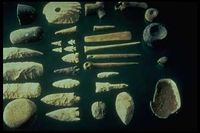Key Concept 1.1 Big Geography and the Peopling of the Earth
Imagine what it would be like looking at the surface of the earth from outer space if all you could see were big trends. You perceived no individuals, specific dates or buildings, just the movement of people, the spread of beliefs, groups, technologies and diseases, and the blending of these things when groups came into contact with each other. This perspective is called Big Geography, and it assumes a global view of the world's history. Much of AP World History is Big Geography.
One trend you would see in early human history would be the migration of Paleolithic people throughout the world.
The word Paleolithic, or “old stone age,” refers to the period of history in which stones were the most prominent tools humans used. In a more historical sense, Paleolithic means the state of human existence before man discovered agriculture. Archaeologists have found evidence that these people travelled around in small, foraging bands that were basically egalitarian. Because they had no consistently reliable source of food, they were almost always on the move.
- I. Archeological evidence indicates that during the Paleolithic era, hunting-foraging bands of humans gradually migrated from their origin in East Africa to Eurasia, Australia, and the Americas, adapting their technology and cultures to new climate regions.
- A. One of the first major advances of early man was the ability to harness fire. Fire sterilized food, brought people together in small groups and protected against predators. Moreover, food cooked with fire eased the digestive process; consequently, more of the body’s energy became available for the development of the brain. This may have helped Homo sapiens develop the capacity for language, giving them a tremendous advantage over other mammals. (See short video on fire and early man.)
- B. Early man developed tools to help him adapt to his environment. Bones, rocks with sharp edges, and small pieces of copper were used to scrape hides, hunt and sew. As these mobile bands came in contact with each other, they borrowed ideas and tools from each other.
- C. Paleolithic people traveled about in small bands, and authority was based on family relationships. Men took leadership roles, but women were highly valued for their gathering skills. Labor was generally divided based on gender, with men as hunters and women as gatherers. However, status differences between men and women were generally not wide, with relative gender equality apparently characterizing their group life. Everyone was equally involved in the acquisition of food.

